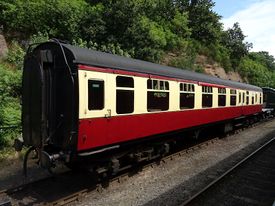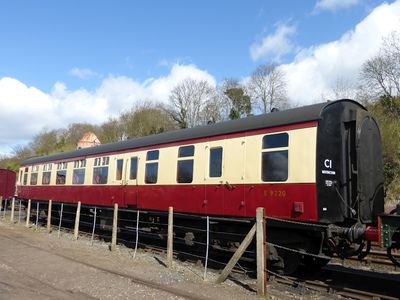BR 9220 Brake Standard Open
| BR 9220 Brake Standard Open | |
|---|---|
 BR Brake Standard Open 9220 | |
| Built By | BR Doncaster |
| Status | In service |
| Number | E9220 |
| Livery | BR Crimson & Cream |
| Other numbers | M9220 |
| History | |
| Built | 1955 |
| Diagram | 183 |
| Lot | 30170 |
| Type | BSO |
| TOPS code | AE21 |
| Seats | 39 standard |
| 1973 | Preserved on SVR |
Contents
Service
9220 was built at Doncaster in 1955 to Diagram number 183 (AE201), and entered service in BR's Eastern Region as number E9220.[2] During the 1960s 'end of steam' era 9220 was part of an excursion set. This set was used during A4 Pacific 60022 Mallard's final run from Kings Cross before preservation,[3] as well as on other rail tours in the North West including one early SVR Society trip after transfer to the Midland Region.[4] The transfer to the Midland Region resulted in 9220 being renumbered M9220 in October 1968.[2]
By 1972, after just 15 years of passenger service, M9220 had been withdrawn from traffic and was in use as a guards' training school on an isolated siding at Leicester Diesel Depot[4], although there is no record of its being transferred into Internal User stock as might have been expected.
Preservation
The SVR's first BR Mark 1 carriage, Corridor Second E24726 was bought by the L.M.S. & B.R. Coach Fund in January 1972 for the 'bargain price' of £100. It saw use until circa 1980 but was then scrapped.
M9220 was the second BR Mark 1 to be preserved on the SVR,[4] arriving from Leicester on 12 February 1973 having been privately purchased by Mr Charles Newton. Another of Charles Newton's carriages Experimental Open 3083, also arrived on the same day.[note 2]
Shortly after its arrival, 9220 became the first carriage on the SVR (and it is believed one of the first anywhere in the UK) to be restored to crimson and cream livery.[4][note 3] It also became the catalyst for the establishment of the Bridgnorth C&W team. It was rumoured at the time that the regular C&W group wanted no dealings with the new Mark 1 carriages on the grounds that they were 'inferior vehicles'. Gary Walker, already experienced in loco painting including 46521, was asked if he would repaint 9220. Hugh McQuade suggested the original crimson and cream rather than the more modern maroon, Gary responded "OK if you'll help" and Hugh agreed. From that small beginning, by the mid-1980s there had grown a thirty-strong Bridgnorth C&W team with eighteen Mark I vehicles in their care.[5]
Having decided on the colour, 9220 had one side painted in crimson and cream livery at Bridgnorth during the closed season of 1973-4, lined and numbered with the E prefix denoting its Eastern Region origin. After a brief period back in traffic, it was moved to Hampton Loade where the painting was finished, before returning to Bridgnorth for lining out and renumbering.[6]
In 1977 9220 established another SVR first when receiving new seats from other recently withdrawn Mark 1 carriages.[7] By 1979 the carriage required some panels welded and was also in dire need of a repaint. It was tentatively withdrawn in spring 1980, but made several further appearances that year, most notably behind GWR 2-8-0 2857 on gauging trials, before work eventually started in November. A change of ownership had seen 9220 come into the L.M.S. & B.R. Coach Fund at Bridgnorth and its members began what became one of the first major rebuilds in the preservation era, paving the way for similar work across the country.[4] At the time some people had expressed the opinion that that you could not chop holes in a Mark 1 carriage without distorting the framework. In the event more than 40 holes were made and repaired, varying from postcard size up to something the size of a carriage door. Two second-hand doors were acquired and fitted, all main windows were re-bedded, and the carriage repainted in the correct BR crimson and cream. The interior was also refurbished, with 9220 re-entering traffic on 27 September 1981.[8]
During winter 1982 9220 became the first SVR Mark I to receive rebuilt bogies. The donor set, which had been recovered from M15553, were dismantled to their component form and re-assembled with new eye-bolts, reinforced bow-girders, new brake blocks and pins and several coats of black paint.[9] By 1986 9220 had established another SVR first as first Mark I to undergo professional reupholstering (and as a result the first to have a thousand pounds spent on it in one go).[10] It ran initially as part of the crimson and cream 'Set C' but increasingly as the usual vehicle for Steam School and Driving Experience specials. During 1987 9220 received its third repaint since arrival on SVR, with the opportunity being taken to give attention to both guard's doors at the same time.[11]
The fabric used in the 1980s re-upholstery was factory-new surplus red tartan cloth acquired from Ilford Electric Multiple Unit Depot. Unfortunately this proved more prone to wear than the normal moquette and by winter 1992-93 more re-upholstery was required. On this occasion 9220's seats were re-covered in red spotted moquette by a sub-contractor who also worked for B.R. at Tyseley. The work was completed in accordance with the new B.R. post-Kings Cross fire safety standards which ended the use of stuffing materials such as horse- hair or pig-hair and required timbers to be painted in fire-retardant paint.[12]
At the end of 1993 9220 was taken out of service for what was expected to be the simple task of installing new lino throughout and the routine re-bedding of window glass before a return to service at Easter. Removing the seats to gain access to the floor revealed that a number of side wall timber panels had become de-laminated with age, and these were replaced. While re-bedding the main window glasses, a number of panes of ordinary plate glass were found which were scrapped and replaced with toughened glass. The lavatory had been locked out of use for 12 months due to a burst pipe, as a result of which the timber fabric of the partition wall become rotten to almost two feet above the floor. This damage was repaired and the lavatory returned to use. The guard's compartment was also found to require a repaint. The decision was therefore taken to carry out a full repaint at the same time. This was completed in December 1993, after which several weeks were spent attending to the gangway steelwork, dampers and canvases at both ends. In another (unwanted) first, one gangway was found to be held at the top by only one bolt, the other three all having become undone or dropped out, resulting in a programme of checking all the others from then on as they come in for work to be done.[13]
9220 suffered a leaking roof-tank in early 1996 requiring the ceiling and roof tank to be taken down while repairs were made. An issue with the electrical fuses was addressed at the same time. The work occupied four volunteers for several days.[14]
In 2006 9220 underwent a temporary repaint into maroon livery pending its next full overhaul.[4][15] The following year 9220 and the other LMS&BR Coach Fund vehicles were transferred to the SVR Rolling Stock Trust. In May 2009 9220 went into Bewdley paint shop, for door ends and three external doors to be replaced. It was completed at the end of 2009.[16]
Back in its regular crimson and cream livery, 9220 continued as the 'driving experience' brake although it was used to reinforce Set M during the 2014 Diesel Gala[17] It received a further repaint in mid-2015 before use in the September Autumn Steam Gala as part of Set N. Some reproduction 1950s 'chain link' pattern moquette was also acquired to be fitted in 2016; SVR News noted at the time that "9220 does duty as the Footplate Experience coach and we like to present a vehicle in good condition for this premium work"[1].
It had lots of attention in 2022. It was put on accommodation bogies while its own wheelsets went to Bristol for tyre turning. All doors were examined and lock and strikeplate renewals carried out, plus minor repairs to door panels and jambs. It returned to service in November.[18]
9220 has been owned by the SVR Charitable Trust since 2007. The photographs show 9220 in the livery it has worn between 1955 and 1960 and from 1973 to date apart from a brief period. The Trust's website states that "We believe 9220 has carried the carmine and cream livery longer than any other vehicle in the country[4].
In April 2023, 9220 moved on hire for the summer to the SRPS at the Bo’ness & Kinnell Railway.
See also
Notes
- ↑ BR later rebranded Second class as Standard class. The 'S' in BSO can be read for either.
- ↑ The Charitable Trust and SVR News both name 9220 as the second arrival and thus longest serving. The SVR Stock Book suggested 3083 was second.
- ↑ Crimson and cream is also referred to as 'carmine and cream' or more informally as 'blood and custard'. www.bloodandcustard.org states that 'crimson and cream' was the term used by BR.
References
- ↑ 1.0 1.1 SVR News 193
- ↑ 2.0 2.1 2.2 Longworth (2013) p.83.
- ↑ SVR News 193
- ↑ 4.0 4.1 4.2 4.3 4.4 4.5 4.6 SVR Charitable Trust
- ↑ SVR News 80
- ↑ SVR News 36
- ↑ SVR News 43, 80
- ↑ SVR News 59, 61
- ↑ SVR News 68
- ↑ SVR News 80
- ↑ SVR News 86, 87
- ↑ SVR News 105
- ↑ SVR News 111, 113
- ↑ SVR News 119
- ↑ SVR News 163
- ↑ SVR News 185
- ↑ SVR News 188
- ↑ Branch Lines, December 2022
Links
| ||||||||||||||||||||||||||||||
